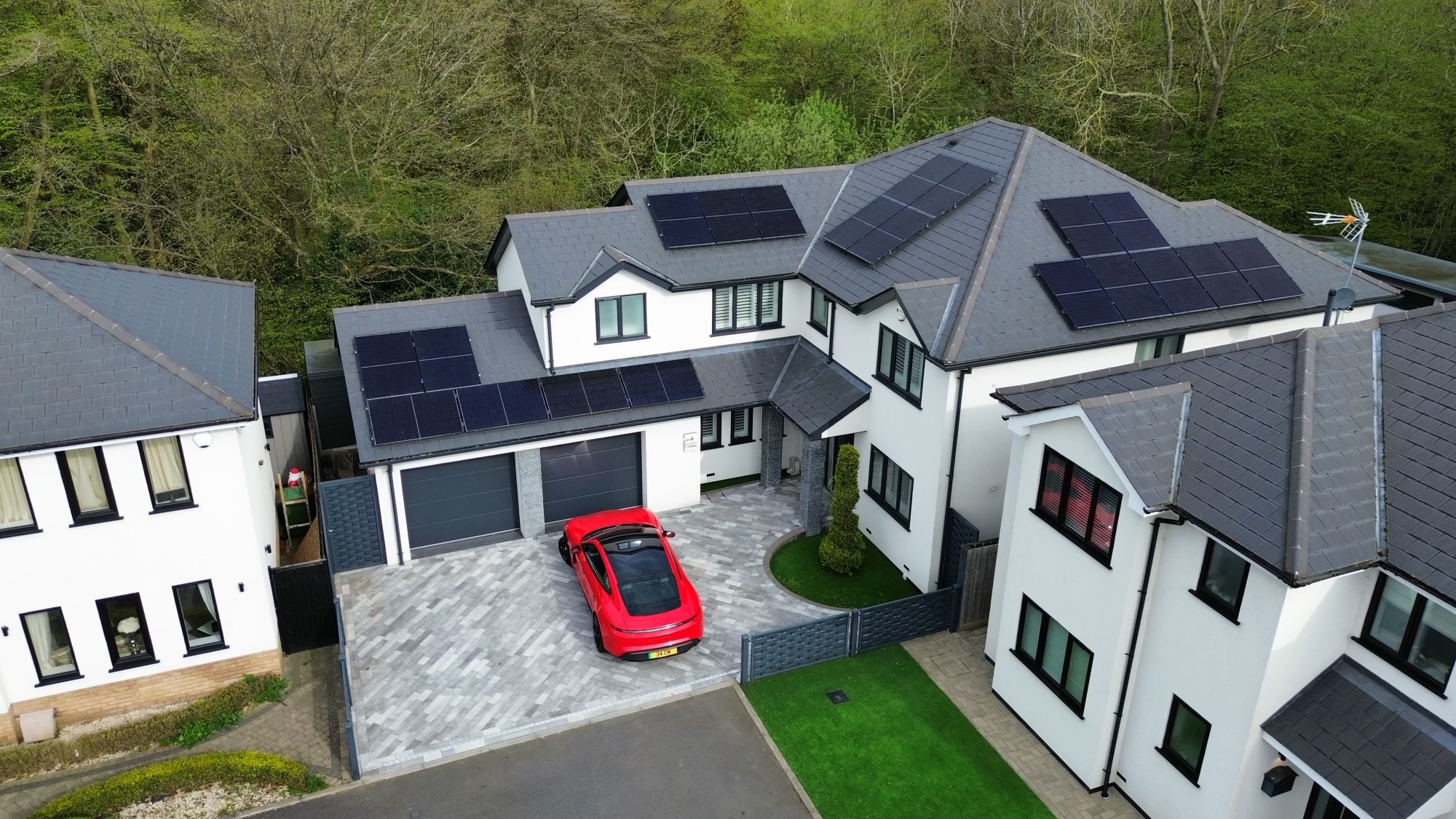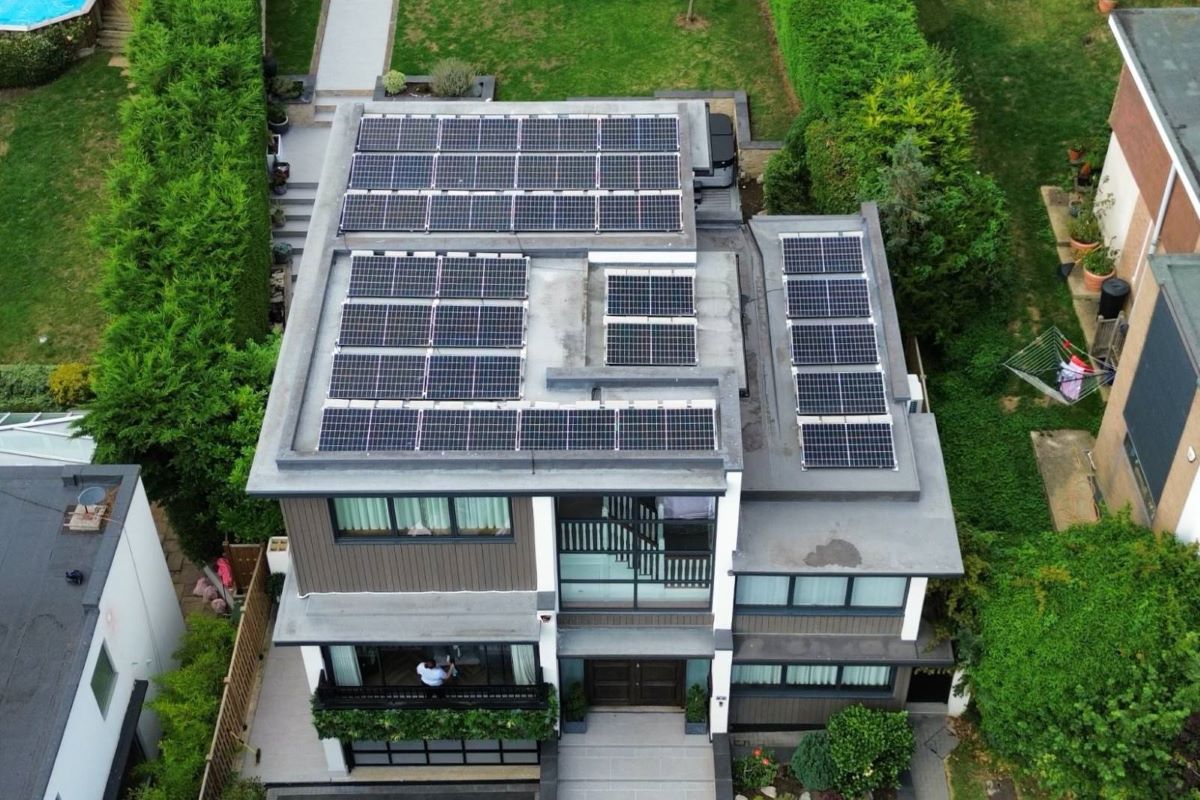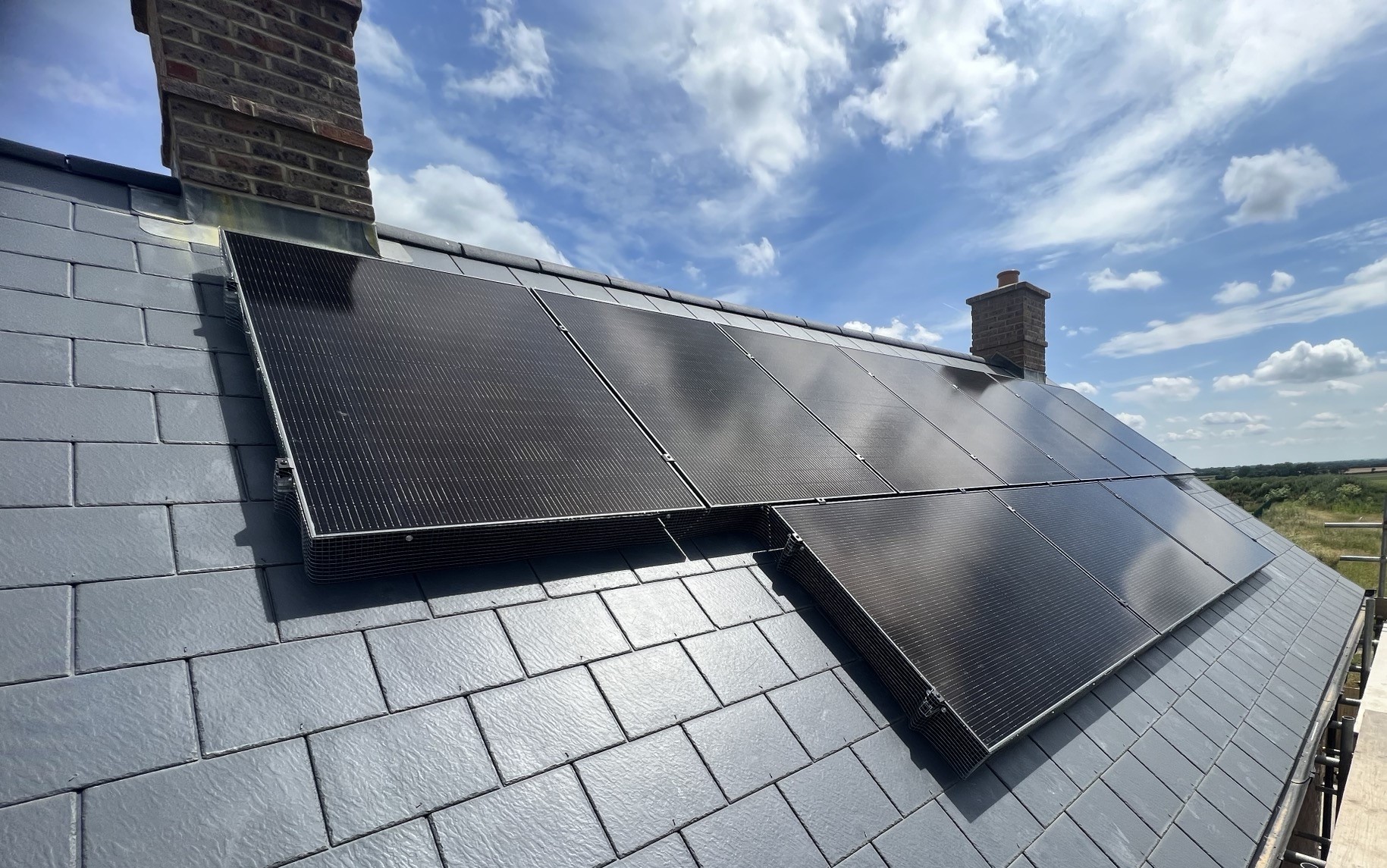Discover how solar panels can be effectively installed on flat roofs. Learn about benefits, installation tips, potential drawbacks, and key considerations.
Can you install Solar Panels on a Flat Roof?
It is a common misconception that solar panels are not suitable for flat roofs, but this is usually not the case. Most flat roof properties are suitable for flat roof solar panel systems, often with equal or even better results than pitched roof installations due to the flexibility in mounting options.
With the right system design, a flat roof solar panel system can maximise the energy captured and yield excellent results.
How do you install Solar Panels on a Flat Roof?
When we are approached by a customer asking about flat roof solar panels we firstly explain that, as an installer, this is not an issue – it simply means we can set our own angle for the solar panels. A lot of the technical aspect of solar panel installation is about angles – how many degrees from south the panels will face, the angle the shading is coming from, etc. And one of the most important angles in this process is the pitch of the solar panel. The ideal pitch for a Solar Panel in the UK is between 20 to 40 degrees off the horizontal, as this allows the panels to gain more exposure from the sun throughout the entirety of the day. On a sloped roof, this angle is dictated by the roof itself, but with a flat roof this angle can be set for optimum balance.
Flat Roof Solar Panel Mounting Frames
Flat roof solar panels are usually mounted onto metal frames that are tilted at the required angle. This is a system that can sometimes be even more versatile and can generate a greater amount of electricity due to it being optimised better than a pitched roof can be, as it is less reliant on the orientation of the building and roof gradient, thus providing more options. If there is no shade on the flat roof, the solar panels can be oriented directly south, oriented with the building, or set up in an East-West split arrangement, depending on which option provides the best results.
The mounting frames used for flat roofs are usually ballasted, avoiding the need to penetrate the roof surface. This reduces the risk of leaks and helps to leave the roof’s warranty unaffected. However, some flat roof structures may not be able to support the extra weight of the ballast, and in these cases it may be necessary to fix the mounting frames directly to the structure.
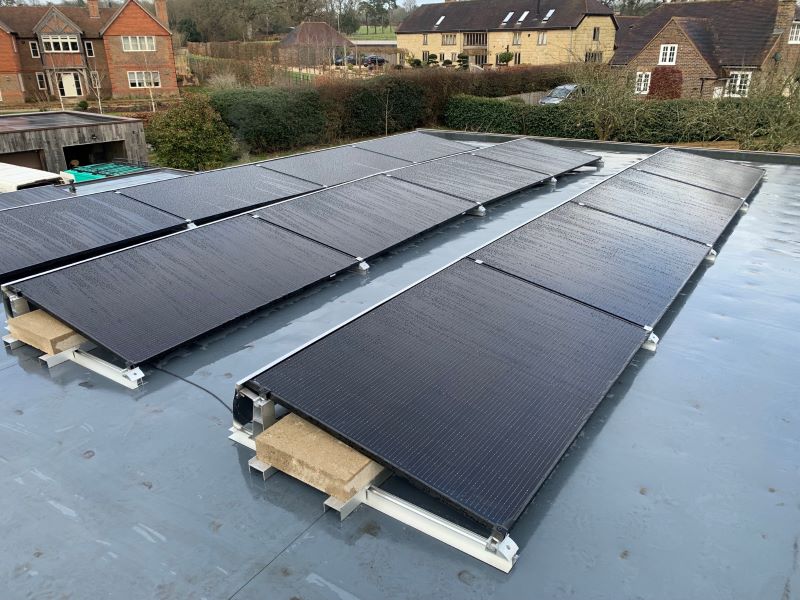
Key Considerations before installing Solar Panels on a Flat Roof
- Roof Condition – The roof needs to be in good condition prior to starting solar panel installation.
- Roof warranty – Check that installing solar panels won’t affect the roof’s warranty.
- Roof structure – Check that the roof is capable of supporting a free-standing ballasted solar panel system.
- Shade – Taller buildings, trees, chimneys and other obstructions can cause shaded areas on flat roofs which could alter the efficiency of a solar panel system.
Optimal Orientation and Pitch of Flat Roof Solar Panels
As we mentioned before, there are a number of orientation options available when mounting solar panels on a flat roof. The best orientation for solar panels in the UK is due south, and when dealing with a pitched roof, south-facing is perfect – but flat roofs don’t necessarily “face” any direction. So what is the best approach?
If a building is nearly south facing, then it is usually best to arrange the solar panels with the footprint of the building. In most cases, the decrease in energy generation due to not utilizing all available flat roof space is greater than the loss from not having the panels oriented directly south.
In the example below, building A and building B both have equal roof space and both face 20 degrees away from south. The flat roof solar panel system on building A comprises of 20 panels oriented in line with the footprint of the building to maximise the roof space. Building B has all the solar panels oriented directly south, but as a result can only fit 13 panels in the same space. In this scenario, the annual generation of building B is 35% lower than building A despite all the panels facing directly south.
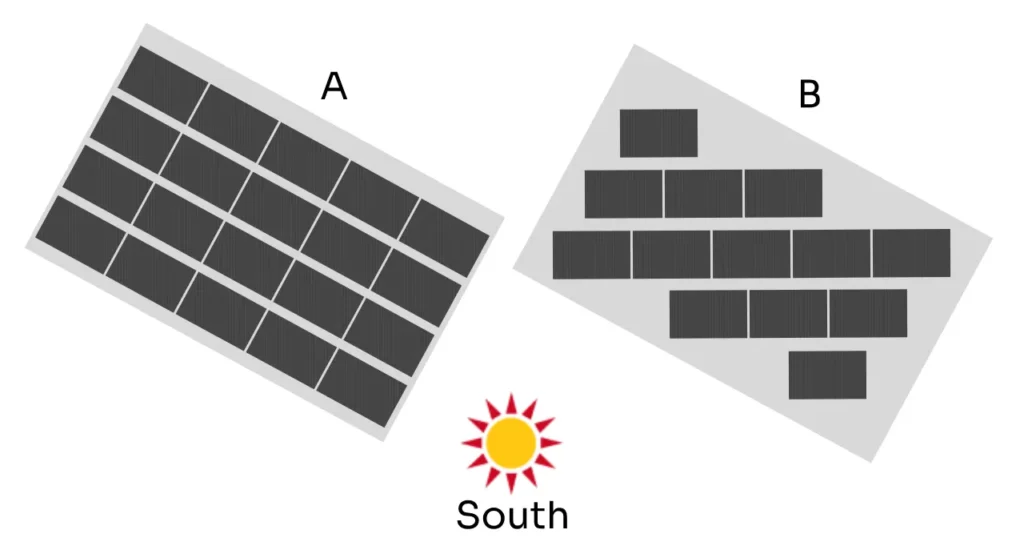
Flat Roof Solar Panels in an East/West Split Arrangement
Another configuration that may be preferable when installing solar panels on a flat roof is the East-West Split arrangement. This uses the same mounting system as a south-facing design, but instead the panels are facing away from each other, oriented east and west. The main reason for this design is to optimise roof space, as no gap is required between the panels to prevent shading. In this arrangement, the individual output from each individual panel is lower, but the efficient use of space means overall system output is often higher.
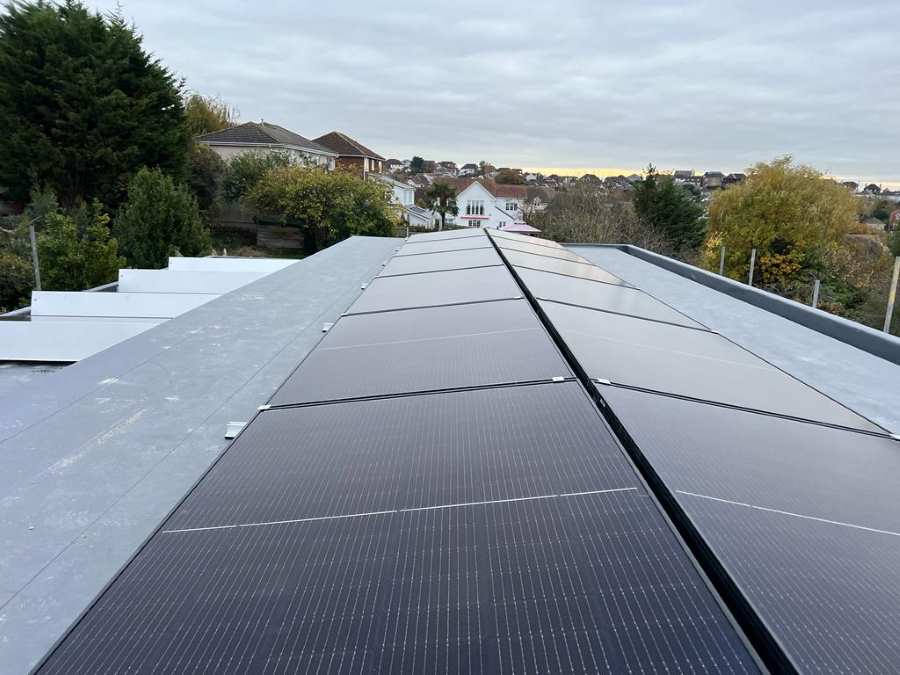
Pitch of Solar Panels on a Flat Roof
The aim is to catch as much sunlight as possible, so solar panels are typically installed at an angle of 20-40 degrees. However, in a flat roof solar panel system, this angle can sometimes be as low as 10 degrees. This is done to prevent the back edge of the panels shading the row behind without having to waste as much space between rows. A lower pitch will also reduce the effect of wind on the solar panels, which is an important consideration on ballasted mounting systems.
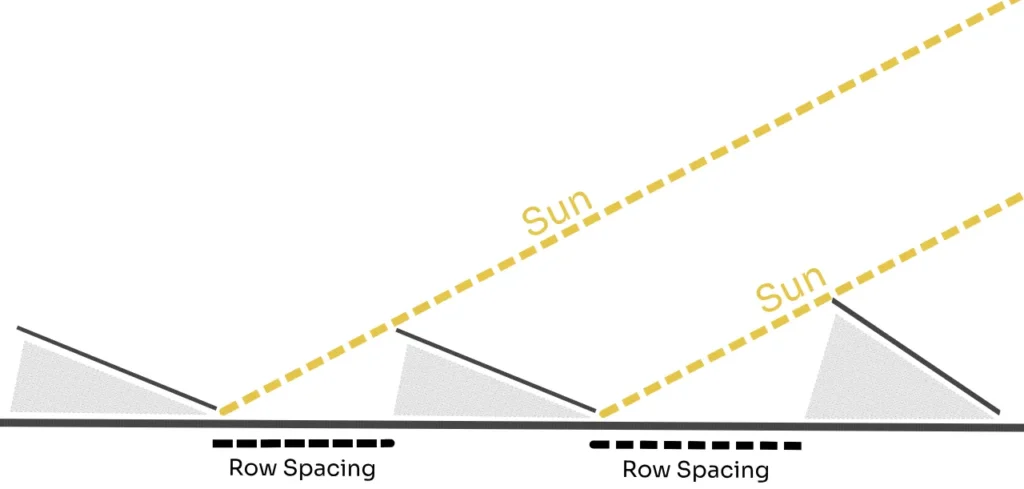
Download our solar guide
Get our free guide to Solar Panels. The best resource for starting your journey into Solar.
What are the benefits of Flat Roof Solar Panels?
- Your property will benefit from clean renewable energy.
- With flat roof solar panels there is more scope, the installer has a number of options to optimise the available space, meaning a greater yield from the system.
- When solar panels are installed on a flat roof, this can be more discrete and is rarely visible from the ground.
- Flat roofs usually provide easy access, meaning plenty of space for installation and maintenance. This can also reduce the need for scaffolding and make installation easier which can reduce the cost of a flat roof solar panel system.
To see the real-world benefits of solar panels on a flat roof and how this has worked for one of our residential customers, take a look at our case study about a flat roof solar panel installation on its one-year anniversary. This installation is yielding fantastic savings for our customer who has a bespoke flat roof solar panel system from us, specifically designed to optimise the generation potential.
Are there any cons to installing Solar Panels on a Flat Roof?
Only a couple…
- When solar panels are installed on a flat roof they can sometimes take up more space per KW than an pitched-roof solar panel system. This is due to the positioning of the panels, there needs to be separation between rows in order to prevent any shading. However, as we have discussed, there are a number of options to optimise the space on a flat roof.
- The roof structure needs to be able to handle the additional weight that comes with the installation of flat roof panels.
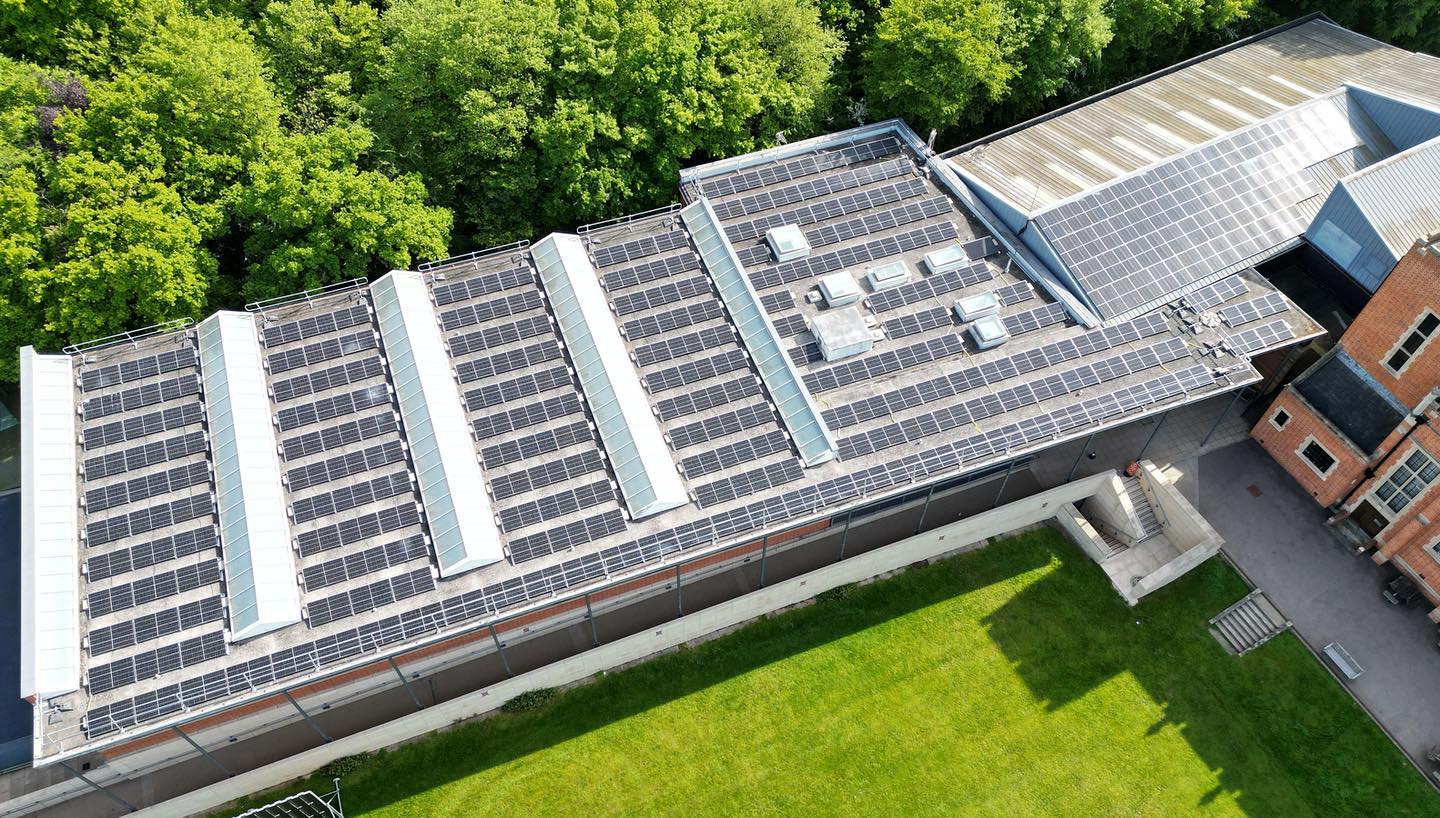
What do I need to consider before installing Solar Panels on my flat roof?
Is planning permission required to put Solar Panels on a Flat Roof?
As a general rule of thumb, planning permission is generally not required. Particularly with regards to solar panels mounted on a flat roof, as these are not usually visible from the ground. However, if you are lucky enough to live in a listed building or in a conservation area the recommendation would be to contact your Local Planning Authority before going ahead with a solar panel installation.
Further information about planning permission can be found on the government’s Planning Portal Website.
Does the wind have any impact on Flat Roof Solar Panels?
As we have mentioned, solar panels on a flat roof are often secured with ballast, if there are high winds, this could potentially pose a risk to a flat roof solar panel system. The pitch of the panels is taken into account to combat this potential issue. However, the panels can also be fixed to a structure if this is deemed necessary. Securing solar panels to a flat roof requires attaching support brackets, which is more intrusive and may affect the roof warranty, so this will all need to be taken into consideration.
Will installing Solar Panels on a flat roof affect my warranty?
It is very important that roof warranty isn’t compromised, and this would need to be checked prior to any installation. As a general rule, a properly-installed solar panel system on a flat roof will not void the warranty – in fact, they may contribute to the roof’s lifespan by protecting the roofing materials from wear caused by sun and weather. That being said, we would strongly recommend checking the terms and conditions of your specific warranty agreement.
Next steps…
If you are considering installing solar panels on a flat roof, it is best to seek advice on the feasibility and find out what options are best for you. As with any solar panel installation, there are a number of considerations to take into account when installing solar panels on a flat roof.
For most people, solar panels are an investment, and like any investment you need to know you are making the right decisions. Here at SolarTherm UK we don’t use one-size-fits-all solutions – we assess each installation individually and tailor our solutions based on the specific requirements of the customer.
This is particularly true with flat roof solar installations, and we have had a number of customers in the past tell us they didn’t think their roof was feasible as another installer would not install on a flat roof. It is rarely the case that a flat roof simply isn’t viable for solar panels. However, it does require a different approach to a pitched roof which is why some installers avoid these jobs.
At SolarTherm UK we have designed and manufactured our own solar panel mounting systems for flat roofs and have used these for residential and commercial installations across the country.
If you are looking to install solar panels on your flat roof, fill in our online quote form, it takes less than 2 minutes and gives us all the information we need to start a design for your property. Or if you would simply like more information or advice, get in touch with us on our contact page, via email, or our live chat below. Want to talk to us directly? Call on 01268 552 868. We are looking forward to hearing from you!

